Content
The pear is perhaps the second most popular fruit tree after the apple tree among gardeners in our country. Thanks to its many varieties, it is grown in a wide variety of regions, but this tree requires more maintenance than many other pome crops. One of the necessary care measures is pruning a pear - a procedure that allows you not only to increase yields, but also significantly improve the health of the tree and extend the period of its active fruiting.
When is the best time to prune a pear: in autumn or spring
Pear pruning can be done not only in spring and autumn, but also in winter and summer. However, this is not always advisable and not all types of pruning can be done at this time. For example, in the summer, you can break out or cut out green, non-lignified shoots if they do not grow properly. This will save the plant strength, it will not have to waste nutrients on the development of such unnecessary branches.
Winter pruning is good because the tree is in hibernation and it will more easily tolerate the surgical procedure. In areas where winters are warm and short, winter pruning is practiced and quite successfully. However, in most regions, there is a high probability of return frosts, so a weakened tree may well die. Pruning in winter is recommended only if the air temperature is kept around -10 ° C, and it is guaranteed that there is no possibility of further lowering.
The traditional time for pruning pears is spring and autumn. Most types of pruning can be done during this time:
- sanitary;
- anti-aging;
- supporting;
- formative.
Spring and autumn pruning have their own timing. Failure to observe them can lead to the fact that the tree will recover for a very long time, and in some cases it may even die.
Pear pruning time
Both spring and autumn pruning of the pear should only be carried out if the plant is dormant. It is absolutely not necessary to delay this procedure. If pruning is done in the spring after the beginning of the growing season, the recovery period will drag on for months, the tree will hurt for a long time, trying to heal constantly weeping wounds. Too late autumn pruning can lead to the fact that a weakened tree will leave in the winter with unhealed wounds and die from frost.
The exact timing of pruning is highly dependent on the climate in the growing region. In spring, you need to focus on average daily temperatures: as soon as the thermometer begins to rise above zero (usually March or early April), you need to get down to business without hesitation.
At the same time, there should be no signs of the beginning of the growing season on the tree, i.e., swollen buds. The spring pruning period is very short. If spring starts together, there is a very high chance that the tree will start the movement of juices, which means that pruning will have to be postponed until autumn.
Fall pruning can take place at a more relaxed pace.It can be carried out in several stages without fear of being late. The most important thing is to meet 2 conditions:
- The tree must go into hibernation (end of leaf fall).
- Before the onset of cold weather, at least 1 month should remain.
Autumn pruning is usually done in early October, and in the southern regions in November.
How to properly prune a pear in spring
Among gardeners, spring is considered the best time to prune pears. Indeed, if all the necessary conditions are met, the recovery period after the procedure will take minimal time, and the tree will improve its health and increase its yield. There are a number of spring pruning rules that must be followed for proper plant growth and development:
- All trimming work must be carried out within a strictly specified time frame.
- The basis of a tree's health is a strong skeleton, so you need to remove competing shoots of skeletal branches in time.
- There should be no forks on the trunk, otherwise there is a high probability that the tree will simply break in two over time.
- The procedure should be carried out taking into account the age of the tree. Excessive pruning of young plants can lead to a significant delay in their development.
- During anti-aging pruning, it is better to remove one large branch than a large number of small ones. In this case, it is necessary to select in advance a substitute escape, to which the direction of growth will be transferred.
- Pear fruiting occurs on horizontal branches, therefore, branches located at right angles to the trunk are promising. All shoots branching off at sharp angles must be removed or their direction of growth must be corrected by means of guy wires or by converting the growth direction by pruning to a strong lateral shoot.
Spring pruning for beginners
How to prune a young pear
In the first years after planting, the crown of a young tree is formed in a certain way. This is done to ensure that fruiting is uniform, as well as for the convenience of carrying out maintenance work. Most often, the crown of a pear is formed in a sparse-tiered way. It consists in the formation of several (usually 3) fruit tiers in the tree, on which the main fruiting takes place.
Pruning a young pear to form its crown in a sparse-tiered way is carried out for several years. This is done as follows. In the first year after planting, the seedling is cut at a height of 65-70 cm from the ground (seedlings on a dwarf rootstock - 50 cm). This will give an impetus to the development of lateral shoots, which will later become skeletal branches of the 1st tier. For the growth of skeletal branches, several strong buds are left, all located below (in the trunk zone) must be sniffed.
Pruning a two-year-old pear
Pruning a pear seedling in the second year continues the formation of the first tier. For this, 3-4 powerful lateral shoots are left, evenly extending from the trunk and spaced 10-12 cm from each other. They are shortened by about ¼. Pruning is done on an external bud according to the principle of subordination (branches growing below should not rise above those growing above). The central conductor is shortened so that it is 20-25 cm higher than the lateral ones. All other shoots (tops, competitors, standard and root shoots) are removed “on the ring”.
Pruning a three-year-old pear
Pruning a three-year-old pear is not much different from working with a two-year-old. From the shoots of the 2nd level, the 1st fruit layer continues to form and the second begins to form. For him, 2 strong shoots are chosen, directed in opposite directions. The rest are cut “on the ring”.
The center conductor is cut by about ¼. All young shoots of a pear are cut to a length of 25 cm. If the angles of discharge are insufficient, some shoots are folded back and fixed with stretch marks.
Pruning a 4 year old pear
In the fourth year, the formation of the pear tree is usually completed. For tier 3, 1 strong shoot is chosen, which is most successfully located in relation to the skeletal branches of the 2nd tier. Directly above this shoot, the central conductor is cut off.
Pruning a 5-year-old pear and older trees consists in maintaining the given dimensions, lightening the crown and sanitary cutting of diseased and damaged branches.
How to prune an old pear
Often the gardener has to deal with old, neglected trees. Most often they are cut down. However, planting and growing a new fruiting pear tree will take quite a long time. So you can try rejuvenate it by cropping. In this way, even an old tree can sometimes be brought back to life and active fruiting.
Working with old trees has its own characteristics. All work must be done in the spring, in accordance with weather conditions, observing 2 basic principles:
- The air temperature was set above zero around the clock.
- There are no signs of the beginning of the growing season on the tree.
The procedure for rejuvenating pruning of an old pear tree is as follows:
- The central conductor is shortened so that 2 hearth tiers can be formed from the remaining branches at a distance of 1 m from each other. Sometimes the tree is simply cut in half.
- On each tier, 7 strong branches are left, the rest are cut "on a ring"
- On all left skeletal branches, improperly growing, crossing, competitive, diseased and broken shoots, regardless of their thickness, are removed, and also tops are pruned on a pear.
- All young growth on the trunk and in the root zone is removed.
In this way, the inner space of the crown becomes open, it receives more sun, air exchange is normalized inside the tree. This stimulates the growth and development of young shoots and restores fruiting.
How to prune a columnar pear
Columnar trees are becoming more and more popular nowadays. They are distinguished not only by good fruiting, but also by a beautiful appearance. At the same time, the compact crown and small size make it very easy to take care of the tree. Columnar cropping pear is the timely removal of sick, broken and dry branches, as well as maintaining the crown of the tree in the required dimensions. With a decrease in yield, thinning is carried out, removing part of the thickening shoots.
Pruning dwarf pears
Dwarf pear varieties are similar in principle to the formation of an ordinary tree. A dwarf pear is formed as follows:
- In the first year, the central conductor is cut at a height of 0.5 m.
- In the second year, the entire annual growth is shortened to a height of 40-50 cm. Branches growing at an acute angle to the trunk are cut “on a ring”. The center conductor is cut 40 cm above the highest lateral branch.
- In the third year and subsequent years, horizontal branches up to 30 cm long are left for fruiting, strong ones are cut into 2-4 buds.
- The center conductor is shortened to a height of 0.4 m above the tallest branch, as in previous years.
To increase the angle of discharge of lateral shoots at a more mature age, you can use twine stretch marks.
Features of pruning pears in summer
Summer pruning of an adult pear is the pinching of improperly growing young shoots - panning. It is done with fingers and nails. Green, non-lignified shoots lend themselves to panning very easily.This kind of pruning of pears in June-August can significantly reduce the amount of work in the fall, and also stimulates the tree to send nutrients not to forcing extra branches, but to ripening the fruit.
In addition to panning, in the summer it is sometimes necessary to carry out a forced sanitary pruning of pears. The need for it arises if the tree has been damaged as a result of strong wind, hail or other factors. Sanitary pruning may also be required in the event of illness or pest infestation.
Pear pruning rules
The pear tree grows intensively only in the first years of life, then the growth rate decreases. To prevent the plant from causing serious damage to pruning, certain rules must be followed:
- In order for the tree to grow and bear fruit well, pruning must be done annually.
- In order not to complicate the work with the crown, after planting, the seedling must be cut off at a height of no more than 1 m and no less than 0.6 m, otherwise the lower fruit layer will be too high or very low.
- Removal of shoots "on the ring" is done at the base of the annular bead in the place where it begins to grow. Too deep an incision will take a very long time to heal, but if you leave a large stump, then an escape will begin to develop from it again.
- The bud pruning is done above the promising bud. In this case, the direction of the cut should coincide with the direction of its growth, and the apex of the cut should be at the same level with the apex of the kidney.
- Tops can be removed throughout the season.
- The growth of skeletal branches must be transferred from vertical to horizontal by pruning to a strong lateral bud.
- All growths are transferred to lateral shoots according to the principle of subordination: strong at the bottom, weak at the top.
- Competitive shoots growing parallel to the center conductor must be removed.
Compliance with these simple rules will contribute to long-term active fruiting and keep pear trees healthy.
How to properly form the crown of a pear
The formation of the crown of a pear begins immediately after planting and ends in the 4th year in the spring. During this time, 2 or 3 fruit tiers are formed in the crown. Different varieties of pear trees have different degrees of branching, therefore the number of skeletal branches is made different. In weakly branching varieties, 7-8 are laid, for highly branching, 5-6 are enough.
How to prune a large pear
A fully formed pear tree has a height of 4-4.2 m. It must be maintained within these limits. Therefore, it is very important to cut vertically growing shoots in time or transfer their growth to lateral ones. To work with the upper tier, you can use a special pruner with an extension or a ladder. The transparency of the crown is of great importance, therefore, thickening branches must be constantly removed from mature trees.
If a pear has two trunks, which one should be cut
In most cases, the pear tree has a pronounced central conductor, that is, one trunk. The second trunk is a competitor shoot not cut out in time. As a rule, the main trunk has a branched crown, but the competitor is straight and fruiting on it, as a rule, is absent. It is necessary to carefully examine both barrels. It may well turn out that the second is a top. Such trunks definitely need to be cut down.
If the trunk grows from the trunk below the grafting site, then this is a non-varietal growth. It can be used as a rootstock for grafting cuttings of the desired variety, if the fruiting tree is old enough and is planned for cutting.
Is it possible to cut off the crown of a pear
The crown (the top of the center conductor) is trimmed repeatedly during the crown formation process. The last time it is cut off for 4 years, transferring growth to a lateral shoot and thereby laying the third fruit layer. The crown is never cut off only in columnar pear varieties.
Pear pruning scheme
In addition to the sparse-tiered, the following schemes can be used to form the crown of a pear:
- Improved tiered.
- Cup-shaped.
- Fusiform.
- Semi-flat.
In accordance with which of them to form a fruit tree, the gardener himself decides. If desired, you can form a pear even with a bush. Each of the schemes has its own advantages and disadvantages.
For example, a bowl-shaped one can significantly reduce the height of a tree, which is convenient when working with a crown, but greatly increases its dimensions and fruit load on skeletal branches. Fusiform is convenient in that it allows you to form a small pyramidal tree with a relatively high yield.
Conclusion
Pruning pears in spring is essential. However, it is worth considering that the gardener does not always have the opportunity to combine his personal free time with suitable weather conditions. Often, the first visit to the garden after winter comes at a time when the trees have already entered the growing season. In this case, you should not try to prune at any cost. If the deadline is missed, it is better to postpone it to the autumn period.
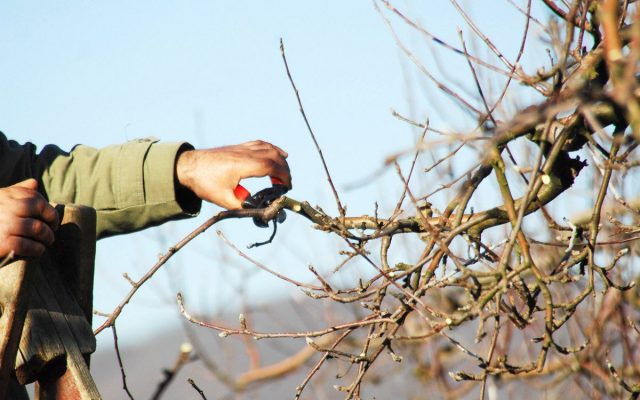
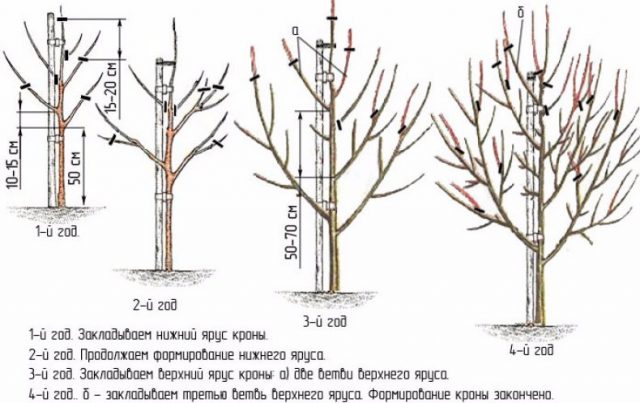

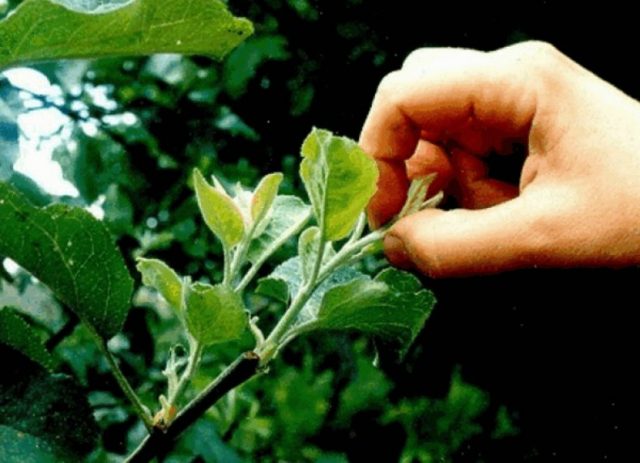
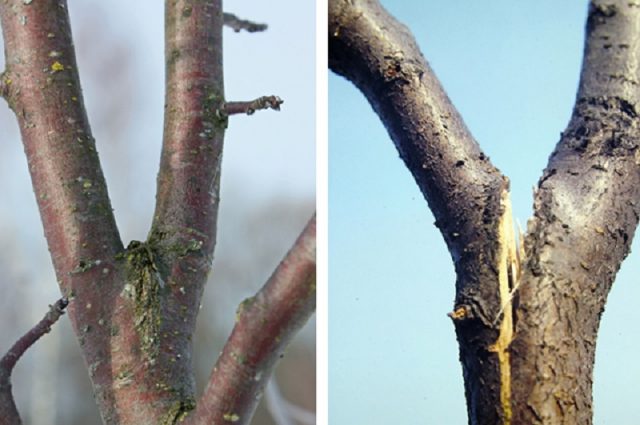
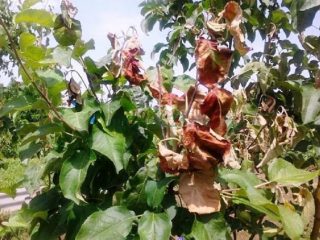

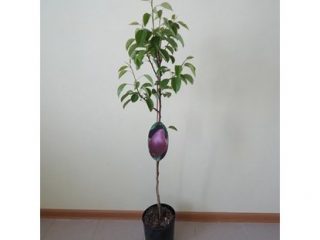

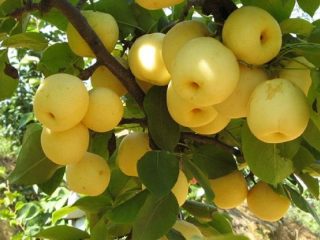



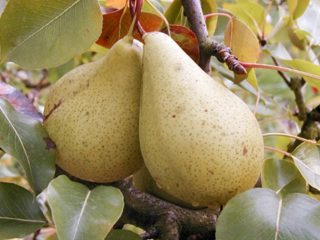
Good afternoon, dear Inga!
A step-by-step scheme for pruning a dwarf pear is described above, in the corresponding section of the article.
We wish you high yields!
Hello! Tell me how to cut a dwarf and super-dwarf pear.